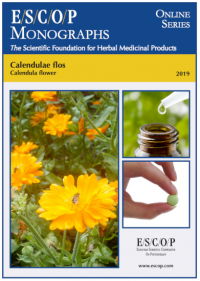
ESCOP monographs, The Scientific Foundation for Herbal Medicinal Products. Online series. Calendulae flos (Calendula flower). Exeter: ESCOP; 2019.
Calendulae flos
Calendula flower
Calendula officinalis L.
Published 2019
Format: PDF, 20 pages
>> Descargar la monografía (20¤, 16¤ para los socios de SEFIT)
>> ver online (¤30/año; gratis para los miembros de SEFIT)
SUMMARY
The herbal monograph selects and summarizes scientific studies regarding efficacy, dosage and safety, that are relevant to the therapeutic uses of calendula flower. This herbal substance by definition consists of the dried leaves of Calendula officinalis L.
Studies with its main characteristic constituents, triterpene saponins (mainly oleanolic acid glycosides), free and esterified triterpene alcohols (especially faradiol mono- and diesters) and carotenoids, are included.
The therapeutic indications are minor inflammations of the skin and mucosa and as an aid to the healing of minor wounds.
Administration of calendula flower addresses posology; its duration of use; contra-indications; special warnings; special precautions for use; interactions with other medicinal products; other forms of interaction; in pregnancy and lactation; its effects on ability to drive; undesirable effects; overdose.
In vitro experiments with calendula flower demonstrated wound healing, antiviral, antimicrobial, immunomodulatory, anti-inflammatory and antioxidant properties.
In vivo experiments in animals showed wound healing, anti-inflammatory, antioxidant, antitumour, photo- and hepatoprotective activities.
Pharmacological studies in humans concerned repellent and anti-irritative effects.
Controlled clinical studies with calendula flower demonstrated its use for wound healing, the treatment of radiation-induced skin damage, gingivitis, periodontitis, diabetic ulcers and vaginal candidiasis in patients.
Preclinical safety data for calendula flower were assessed in toxicity studies.
Safety data were assessed in human studies.
The selection of literature cited in the monograph, is aimed at compiling relevant examples of the possible physiological roles of calendula flower and its major constituents.
KEYWORDS
Calendulae flos
- Calendula flower
- Calendula officinalis L.
- Minor inflammations of the skin and mucosa
- Aid to the healing of minor wounds
Reference: European Scientific Cooperative on Phytotherapy. ESCOP monographs, The Scientific Foundation for Herbal Medicinal Products. Online series. Calendulae flos (Calendula flower). Exeter: ESCOP; 2019.



